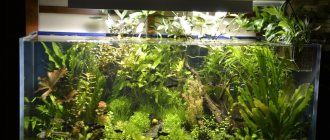How aquarium feeders work
Automatic feeders for aquarium fish, regardless of the device model, operate on the same principle. The essence of the action is that food is dropped into an artificial reservoir in the specified quantity, at the time set on the device timer. After the fish treats are thrown into the water, the drum rotates and the food compartment is refilled with food. The volume of food is controlled by a plate, which multiplies or decreases the weight of the portion, and the serving time is set using a control unit.
The device for serving food operates from a battery or electric current. If the owner is away from home for only a day, then it is better to choose the first type, and if he goes on business trips, then the second.
Comparison of automatic robotic fish feeders
We compared several automatic fish feeders to understand the issue of robotization of the process of feeding aquarium fish and reptiles without human presence.
EHEIM - automatic feeder for daily fish feeding
It comes with a volume of 100 ml. It can be programmed via the LCD touch screen to, for example, feed your fish up to 8 times a day.
It can be used to dispense most types of food, and you can even use it to feed frogs, newts, and turtles.
Fish feeders can also be purchased in our store
It is easy to install using a guide and a universal installation clamp.
Using the adjustable slider, you can set the serving size. There is also a manual feed button so you can feed your fish outside of a pre-programmed schedule. The feeder is designed to not stop even if the feed slot is upside down. It is transparent, so you always know how much food is left inside. Thanks to the built-in fan and internal ventilation system, the food always remains dry.
The feeder is very reliable and the buttons are splash-proof. The charge lasts up to 6 weeks of feeding if you use not one, but 2 AA batteries. There is a two-stage charge level indicator that will warn you early enough that it is time to change the batteries.
There are no negative aspects to the EHEIM fish feeder, and even the price was quite affordable. The manufacturer guarantees at least a year of continuous operation without maintenance and you can really rely on this robot. It's easy to set up and use. It also comes with a 3-year manufacturer's warranty.
However, some may have a few questions regarding the breakage of the feeder parts. Overall the build quality is very good, which explains its reputation in the robot market and why it has received so many appreciative reviews.
Perhaps the only thing wrong with it is that it doesn't have an off button, but I personally can't see a good enough reason why you'd want to turn it off. Remember that if you remove the batteries to turn off the feeder, you will have to reprogram it later.
IntelliFeed automatic fish feeding device
If you have a lot of fish to feed, this is a great option. It is programmed to feed the fish twice a day, and you can dispense up to 12 feeds each day. It works great at retaining moisture from the outside environment so the food inside stays dry and spreads easily. It is also easy to install and configure. Its power is quite powerful and many people rave about its ability to keep your fish alive even after being on vacation for 3 weeks or more. The batteries are quite reliable, and as a special bonus there's even a power adapter so you're not completely reliant on batteries. Once you set it up, it is very easy to use.
A fish feeder has a lot of moving parts, so there is a higher chance that a part will break. But, judging by the reviews, it has been working for more than a year without any problems. The problem is that it is not entirely easy to access the battery pack once the fish feeder is set up and installed. These are all minor complaints, since even those users who broke it after 3 months are still planning to buy it again.
The only other problem is that all these great features don't come cheap.
Advantages
* reliable * Can feed a lot of fish * Effective against moisture
Flaws
*Quite expensive *Batteries are not easy to access
Hydoor - automatic fish feeder
This is one of the most reliable candidates you can find in the market if you want to feed your fish automatically. The design is exceptional so you won't have to worry about any breakage. Even moisture is not a problem - the food remains dry.
You can feed your fish 1 to 3 times a day, depending on the food serving option you use. The amount of food you ship at a time is also adjustable.
The battery power is used very efficiently, so even with 3 feeds a day you won't have to change batteries for 9 or even 10 months. There is a low battery indicator so you will know when it is time to change the batteries.
The only major problem with the build is that it is not that easy to set up, as you only have limited options when mounting it. And one problem with the design is that the food container isn't very big.
And programming the actions of the feeder is not entirely flexible. First of all, it's too complicated. Secondly, you can choose only prescribed eating schedules, such as twice a day every 12 hours or 3 times a day every 8 hours.
And there is no way to set feeding times later. If you want to set up the feed at 8am, you need to wait until that time to set it up.
Advantages
*Extremely reliable *Can last a very long time with batteries
Flaws
*Difficult to set up *Loses programmed parameters
Meco - automatic feeder for aquarium
Many people complain about this feeder because it is difficult to set up. But the point is that you need to read the manual if you want it to work properly.
If you do this, it will do what the manufacturer promises and it will feed your fish up to 4 times a day with controlled amounts of food.
The device is a little bulky, but setup is not difficult. The feeder uses 2 AA batteries, but it does not work with rechargeable batteries. The size of the food compartment is only good for feedings for 2-3 weeks. You won't be able to go on a month-long vacation with this feeder.
This is the cheapest lot and the quality is quite good for the price.
Advantages
*Quite affordable
Flaws
*Not intuitively adjustable *Food container is very small
Automatic fish feeder Rusee Daily
The Rusee automatic feeder is a battery-powered life support system for aquarium fish that is mounted on the edge of the aquarium.
The battery powered motor is controlled by a timer function.
Fish food is contained in a rotating plastic hopper. The sliding window controls how much food falls out of the hopper when a timer tells the motor to spin.
Each time the motor rotates the feed hopper, one reset occurs. Fish food enters the aquarium water when the hopper is turned over for a short time.
The timer can be programmed to serve fish up to six times within a 24-hour period. Setup is as simple as setting a digital clock. Plastic pins are placed on the dial to indicate when to feed. The timer can be disabled for manual feeding.
The Rusee Automatic Fish Feeder can dispense a variety of feeds including flakes, pellets, crumbs and pellets up to approximately 5/16".
Since it is battery powered, the Rusee automatic feeder can be used outdoors without the risk of electric shock. It is possible to feed pond fish while you are away from the pond, but you will have to build a small bracket to hold the feeder near the edge of the pond.
Advantages
*Budget. *Battery powered during power outages. *Distributes a variety of product types. *Feeding several times a day.
Flaws
*Precise dosing of food is not possible. *It is not possible to feed different foods on different days like with more advanced feeders. *The timer is not synchronized by the crystal and lags when the battery is low.
Advantages and disadvantages
Automatic aquarium feeders have individual advantages and disadvantages. The advantages of a device for feeding fish food are:
- Systematic nutrition.
- Control the number of portions.
- The ability to serve food in one place to clean the soil more efficiently.
- Possibility to leave pets for an extended period of time.
Disadvantages of use:
- It is impossible to feed babies who feed on ciliates and living dust, since the automatic fish feeder supplies dry food.
- Use only flake or granular types of food. To feed your pets with live food, you need a fish feeder, which is filled manually by the aquarist.
- Possibility of device breakdown – a working device tends to break down after prolonged use. If you plan to leave for a long time, it is advisable to have someone visit the house and check the operation of the device once a week.
- Cost – the price of aquarium feeders varies from 1,500 rubles and above.
DIY automatic fish feeder
Let's look at how to assemble an automatic feeder with your own hands using Arduino or any other microcontroller. The device is made of a 5-volt stepper motor 28BYJ-48 in symbiosis with a real-time clock model DS1307.
A homemade feeder has the ability to serve fish food at a given time, dispensing two types of food at the same time.
Tools and materials
You will need:
- plexiglass 5 mm thick (1.5 square meters);
- a bottle of Dichloroethane glue;
- hot glue;
- fine sandpaper;
- cosmetic cotton swabs (for applying glue);
- foil;
- thin knife;
- pencil;
- drill 4 and 8 mm;
- 10 metal bolts with a diameter of 4 mm and 24 nuts of the same diameter (with a margin);
- bolt and nut M6;
- 6 metal bolts and nuts with a diameter of 8 mm;
- metal furniture corner;
- metal pin M6;
- aluminum tube (diameter suitable for M6 stud);
- plexiglass from a CD box;
- electric jigsaw;
- electric drill;
- small bench vise;
- screwdriver;
- hand file.
Important! The type of glue used for this design has a pronounced chemical odor and harmful fumes, so the glued parts should only be dried in the open air.
Step-by-step manufacturing instructions
The procedure for making an automatic feeder is as follows:
- Part No. 1 - made of plexiglass 5 mm thick. Using an electric jigsaw, a rectangle is cut out . Approximate dimensions of this part: length 7.5 cm, width 4 cm, thickness 5 mm. Markings are made with a pencil on the cut out rectangle. As a result of this marking, the contours of two future through holes in the form of rectangles (length 15 mm, width 10 mm) should be marked in the middle of the part. The distance between these two holes is 15 mm. Using an electric drill (8 mm cross-section), several through holes located side by side are drilled according to preliminary markings, so that after modification with a jigsaw, rectangular holes are obtained in these places that exactly correspond to the previously drawn contours. Holes are also drilled in the corners of the quadrangular plate for future fastening of the part. The areas where drilling will be done are moistened with water released from a disposable syringe. The resulting rectangular holes in the center of the plate are processed along the edges with a metal file to smooth out the burrs resulting from working with a drill. Finished part No. 1 is put aside for a while.
- Part No. 1-a - 6 bars are cut from plexiglass : 7.5 cm long, 1 cm wide, 5 mm thick. The bars are glued together in groups of three using Dichloroethane glue. The glue is applied to the plexiglass plate using a cosmetic cotton swab. As a result, after gluing, you will get two thick rectangular bars, the edges of which must be brought to absolute smoothness using a file and subsequent sanding with sandpaper. For ease of sanding with a file, the glued blocks are placed in a bench vice secured to the edge of the workbench.
- Part No. 2 - two more strips are cut out of plexiglass : length 15.5 cm, width 1 cm, thickness 5 mm. Between the two resulting strips you need to glue thick rectangular bars prepared earlier (part No. 1-a). Using a cotton swab, Dichloroethane glue is applied to the side of one of the bars and glued to the first strip of plexiglass . A second block is also glued to it, placing it at the other end of the strip. An empty space of 5 mm is formed between the two glued bars. After that, the upper sides of the glued bars are smeared with glue, and a second long strip of plexiglass is applied to them. For high-quality gluing, the structure is clamped in a vice for a time sufficient for the glue to set. To dry, the entire structure is taken out onto the balcony.
- Using a plate with rectangular holes in the center (part No. 1) as a stencil, use a pencil to mark all its holes on a large sheet of plexiglass. Then, using a drill with a diameter of 4 mm, side holes are drilled on a large sheet of plexiglass corresponding to each corner hole of the stencil plate. Next, a drill with a diameter of 8 mm is used; holes are drilled on a sheet of plexiglass exactly in the middle between the two contours of rectangular through holes. 4 screws of suitable size are inserted into the resulting 4 mm holes and secured tightly with nuts on the back side of the plexiglass. Screw another nut onto the same screws so that there is a distance of 15 mm between the first and second nuts. Part No. 1 is placed on the legs of the screws, in the corners of which special holes are provided for this purpose. To secure it on top of part No. 1, another nut is screwed onto the screws.
- Part No. 3 - take an M6 bolt and nut and place it in a vice for ease of work . Hot glue is applied to the nut in several layers, turning the bolt during the hardening process. The result is a through fastening, which is necessary for further assembly of the structure; it is connected into one piece with a metal corner. The factory hole in the metal corner is pre-drilled to a diameter of 7 mm. They bring dried part No. 2 from the balcony and attach finished part No. 3 to it using a screwdriver . An M6 metal pin is inserted into the hole located in part No. 3 (as the future axis of rotation).
- A coupling is made from an aluminum tube of suitable diameter . To do this, the tube is clamped in a vice and two holes are drilled through which a metal screw is threaded.
- Using a screwdriver, nut and bolt, a 28BYJ-48 stepper motor is attached to a piece of plywood , and a metal furniture corner is also attached there. All the structural parts are assembled on plywood and a stop for the stud is made from a bolt secured with a nut.
- Next, containers for food are made from the lid of a CD box (it is made of fairly thin plexiglass). To create one container, 4 plexiglass parts are cut out in the form of truncated cones. There is no bottom in the container. The finished parts are held together using tape or medical adhesive tape. The side edges of the parts (in assembled containers) are coated with Dichloroethane glue; the glue is applied using cosmetic cotton swabs. For drying, the glued containers are taken out onto the balcony. Two feed containers are made.
- Foil is glued to the underside of the large plexiglass, to which all other parts are subsequently attached . Self-adhesive dark film from a hardware store is glued to the top side of the same plexiglass. In places where there are holes drilled in the plexiglass, the foil and self-adhesive are pierced with a sharp knife. All the parts of the feeder are assembled together at the top of a large plexiglass . The fish food containers are glued to part #1 directly above the rectangular through holes using hot melt adhesive.
- The DS1307 real-time clock module is connected to the almost finished design.
Did you know? The Japanese eat fugu fish dishes with pleasure and amazing fearlessness. The liver of this fish contains a deadly poison; the cook only needs to remove the liver not too carefully for the poison to penetrate into the meat. Although, in fairness, it should be noted that only specially trained people with a diploma are allowed to prepare these dishes.
Video: how to make an automatic aquarium feeder with your own hands
Why do you need a feeder?
An automatic fish feeder is an indispensable device in the following situations:
- Lack of home - those fish holders who live alone cannot refuse to go to work every day. Therefore, the device will take care of the fish on its own. An electronic feeder is also indispensable for those who often leave home for long periods of time, going on business trips or trips.
- Raising fry - breeding fish requires attention and responsibility from the aquarist, since feeding the fry should be done in small portions, but often. Not every owner has the opportunity to feed the fish every 3-4 hours, but automatic feeders can handle this with ease.
- Maintaining cleanliness in the tank - due to the fact that food is served in one place and time, the remaining food will settle in one area of the reservoir. This will allow you to quickly and effectively clean a small area of soil from remaining food, rather than searching for leftovers throughout the entire aquarium, which will keep the aquatic environment clean. In addition, if catfish live in the tank, then the cleaner fish will independently clean the place where the remaining food has fallen.
Why do you need an automatic feeder?
In some cases, such a device can become simply irreplaceable.
For example:
- the owner is at work for 12 hours or more;
- a vacation or business trip is coming;
- young fish or a particularly capricious breed of fish requires frequent feeding.
Did you know? In Japan, imperial carps from palace ponds were awarded to those who distinguished themselves as medals. If the recipient fell into disgrace over time, the imperial fish could be taken away.
Criteria for choosing an automatic feeder
An automatic feeder for an aquarium must meet certain requirements, because the health of underwater inhabitants depends on the device. Considering the cost of aquarium feeders, many fish holders decide to make an automatic feeder with their own hands, using the advice of experienced aquarists. If this is not possible, then the device is purchased in the store, taking into account the selection criteria:
- Fixation – the device must have convenient fastenings and be fixed in a place that is convenient for the owner.
- Ease of use - the device should be accompanied by clear instructions so that the aquarist can independently turn on and configure the device.
- Reliability - the aquarium feeder must work according to the specified settings, preventing random food supply.
Rating TOP 5 best automatic fish feeders
The rating of the best automatic feeders, in our opinion, looks exactly like this:
- Juwel.
- Eheim.
- Sera.
- Sititek.
- Feed-Ex FF03.
Let's take a closer look at the range presented above.
Automatic feeder for aquarium fish Juwel
The presented device with an electronic timer will help the fish stay full, even when you are away from home for a long time. The device is attached to a compartment in the lid of the aquarium and provides food at a selected time interval, maximum twice a day. The model is quite compact and will not cause discomfort to your pets while swimming and eating. The food is not capable of clogging the water in the aquarium thanks to a special filter that prevents food from sticking together and swelling.
| Weight | 32 g |
| Manufacturer | Germany |
| Food serving time interval | 2 times a day |
| Dimensions | 14x6x8 cm |
Price category: from 2435 to 3000 rubles.
- convenient fastening (attached to the aquarium lid);
- individual choice of feed supply time interval;
- compact dimensions (14x6x8 cm);
- light weight (32 g).
- not detected.
I had never heard of this device before, and, by the way, I missed a lot. I often go on business trips and don’t have much time for fish, but my conscience won’t allow me to get rid of them, I’m too used to them. I had to ask neighbors to feed their pets, to which I often received dissatisfied faces and a large sum of money for the service. With the use of this feeder, the budget has clearly decreased, and now I am calm about the fish - they will definitely remain well-fed. The device feeds the pets twice a day, which is enough for the fish. I can set the interval myself, for example, every six hours. Thanks to the manufacturers, I recommend it.
Automatic feeder for aquarium fish Juwel
Automatic feeder for aquarium fish Eheim
The presented feeder is equipped with an electronic display and control buttons that allow you to program up to 4 feedings per day at any time; “double feeding” is also installed - in this case the drum makes 2 revolutions. The kit includes: fasteners that install the device on the side and batteries (2xAA). Also, the presented model has a unique feature - a microfan that operates every time the feeder feeds - thanks to this factor, the food inside the drum does not linger and does not get wet. The drum volume is about 100 ml.
| Weight | 360 g |
| Manufacturer | Germany |
| Food serving time interval | up to 4 times a day |
| Dimensions | 14x6x6.5 cm |
Price tag: from 4450 to 6000 rubles.
- there is a microfan (prevents the feed from sitting and getting wet);
- installation of double feeding (the drum plays 2 revolutions);
- can produce up to 4 feedings per day.
- not found.
The device is really useful and high quality. I've been using it for 3 years, absolutely no problems. I can leave for a week and nothing will happen to my little ones. Thanks to the built-in fan, uneaten food will not affect the purity of the water in any way, because it simply cannot swell and turn into mush. I set it to feeding - 2 times a day. The fish are full, I'm calm. Thank you.
Automatic feeder for aquarium fish Eheim
Automatic feeder for aquarium fish Sera
This device is capable of feeding your fish from 1 to 6 times a day, depending on the installation. The amount of food, number of feedings and feeding time can be easily set by pet owners themselves. The model in question is especially suitable for feeding young fish that require small portions of food several times a day in order to ensure rapid and healthy growth. The round drum holds approximately 80 ml of food and smoothly dispenses it into the aquarium. During the feeding process, large and sticky lumps do not form due to the moderate feeding of food.
Interesting: Rating of the TOP 7 best washing gels: which one to buy, characteristics, reviews, prices
| Weight | 505 g |
| Manufacturer | Germany |
| Food serving time interval | up to 6 times a day |
| Dimensions | 21x14x10 cm |
Price: from 1900 to 2340 rub.
- automatic feeding up to 30 days;
- there are no blockages during feed supply;
- The device can be installed in any desired position.
- not found.
I trust this device more than my own sister. The feeder will not miss the time when I need to feed my little pets in my absence. The price of the model is inexpensive, and the benefits, of course, are enormous. It’s easy to install, I’m a girl and I figured it out the first time. The device does not clog the water with food, preventing it from forming into pieces of porridge. I am definitely satisfied with the device, I recommend it to all lovers of pet fish.
Automatic feeder for aquarium fish Sera
Automatic feeder Sititek
This automatic feeder is capable of feeding your pets from 1 to 4 times a day in portions ranging in size from 0.75 to 13.5 ml (calculated for 215 ml of dry food). It differs from its analogues in its very flexible settings and in keeping the feed fresh and crumbly. Sound and light signals make the model in question as simple and understandable as possible; you will learn about all events in a timely manner. Feeding time, current time and pictogram indicators are displayed on a large display; 2xAA batteries are used as a power source. Installed on the lid/edge of the aquarium - whichever is more convenient for you.
| Country of Origin | China |
| Number of feedings | 1-4 times a day |
| Dimensions | 24x16x50 cm |
| Weight | 3050 g |
Cost: from 2500 to 3220 rubles.
- keeps the food fresh and crumbly (just connect the hose from the compressor to the feeder);
- two mounting options (on the aquarium wall/lid);
- warns of all events with a signal (when the food runs out, you will hear an alarm).
- heavy weight (3.5 kg).
Inexpensive and high-quality device, it copes with its direct responsibilities perfectly. There are sound notifications and scheduled feeding. The feed supply process has never failed, the fish are well-fed and happy. The model is installed as simply as possible; the kit includes the necessary suction cups and other fasteners. Thanks to the manufacturers, I am satisfied with the device.
Automatic feeder Sititek
Automatic feeder for aquarium fish Feed-Ex FF03
The design of this feeder with a programmable schedule is thought out literally down to the smallest detail: the transparent container allows you to see how much food is left without opening the lid, and the lid itself fits tightly and ensures the freshness and safety of the food. For long-term storage and protection of food from moisture, it is possible to connect an air supply. The model can be used for any type of fish, even the smallest ones.
| Country of Origin | Russia |
| Number of feedings | 1-4 times a day |
| Dimensions | 6x9x14 cm |
| Weight | 400 g |
Price category: from 2500 to 3200 rubles.
- Suitable for fish of all sizes;
- a sound signal warning of the end of the feeding cycle;
- low battery indicator;
- compact dimensions (6x9x14 cm).
Interesting: Rating of the TOP 5 best orthopedic pillows for sleeping: which ones to buy, reviews, prices
- not detected.
I use this device every vacation. Some people say that an automatic feeder is a useless device, but I think completely differently. It is configured in a way that is convenient for me, and is capable of feeding them 2 times a day, or maybe up to 4. I also regulate the amount of feed myself. By the way, any food is suitable, there are no restrictions. I'm glad that there are sound notifications when the food runs out or when the batteries are low. Overall I am satisfied with the device, I thank the manufacturers.
Automatic feeder for aquarium fish Feed-Ex FF03
How to build a device
A do-it-yourself automatic fish feeder is made from scrap materials that are easy to find. There are two ways to build a fish feeder with your own hands.
First way:
- For the construction you will need a plastic bottle and an unnecessary telephone that receives incoming calls. The container is cut into two equal parts, then the lid is attached to the neck so that there is a gap between the neck and the cap. After this, the bottle is filled with food and a mobile phone is inserted inside.
- The principle of the device is simple - food enters the aquarium due to vibration, so you just need to call the phone and food will pour out to the fish. The amount of food is regulated by time - while the mobile vibrates, food arrives.
The second manufacturing method is more complex than the first and requires more materials. A do-it-yourself aquarium fish feeder made using this method will work autonomously, and the owner will not need to regularly “call” the pets. For construction you will need:
- Alarm clock with light weight.
- Plastic tube.
- A thick plastic glass with a lid.
How to make:
- A hole is made in the bottom of a plastic glass. The size of the hole should be slightly smaller than the diameter of the tube.
- The tube is inserted into the hole made so that the tip of the tube does not touch the wall of the glass.
- The container is filled with food and tightly closed with a lid.
- The protective glass is removed from the alarm clock, and the drum is attached to the clock hand with tape so that in 24 hours the tube is turned towards the reservoir twice with its outer tip.
The essence of the device is that the amount of food thrown into the aquarium is controlled by the size of the tube. The thicker the hole in the tube, the more food the fish will get. Before use, the device is tested for 2-3 days.
Automatic fish feeders are devices designed to make the aquarist’s life easier and prevent underwater inhabitants from starving. Devices for feeding feed can be purchased at the store, or built at home, but in the second case you need to make sure that the feeder is working properly.
How to make a feeder with your own hands
Automatic feeders can be purchased at a pet store. Before purchasing, you should consult with a specialist. The consultant will be able to select a gadget that suits the needs of your fish. The food will be served automatically depending on the settings you set. But you can save money and make this gadget at home. The principle of operation will be similar to the purchased one.
Phone and bottle
One of the simplest devices is a do-it-yourself automatic feeder made from a plastic bottle and a cell phone. A modern gadget will help you quickly feed small pets.
To create a feeder with automatic feed supply you will need:
- plastic bottle;
- the cap is slightly larger than the neck of the bottle;
- cell phone set to vibrate;
- glue "Moment";
- several small blocks or matches.
Creating a feeder with your own hands consists of several stages:
- You need to start with a plastic bottle. It is cut in half. You will need the top of the bottle, which is screwed on with a cap. It will be used to feed animals.
- Next you should prepare the matches. The sulfur is removed from them. Then they are glued together. The number of matches depends on the feed that will need to be fed. Typically three or four are used.
- After the matches cling to each other, they are glued to the plastic cover.
- The cap is attached to the neck of the bottle with the part where the matches are located. The result should be a structure consisting of a bottle, a cap and matches located between them.
- The device must be mounted above the aquarium. You can use wire or thread for this. If you use the latter, make sure that it does not stretch out, otherwise the feeder will end up in the water and will not function. And the glued matches will quickly get wet, the device will stop functioning, and the glue will negatively affect the condition of the fish.
- Food is poured into the feed compartment. It should be at the top and the lid at the bottom. There is no need to be afraid that the food will spill out; only a certain amount fits into the lid.
- The device is almost ready. All that remains is to set up the automatic feed supply into the water. And this is done using a mobile phone. The gadget must be charged to 100%, the ringer must be set to vibrate.
- The phone is placed in a bottle of food. And then everything is simple. Feed will be supplied by calling the phone from another gadget. By vibrating, the device will create vibrations, under the influence of which the food will fall off the lid. As soon as the external influence stops, food will stop getting into the water.
The main advantage of the feeder is the low cost of the device. Plus, you can independently calculate the duration of the call and the amount of food supplied at that moment. With such a device, you can safely go on a long trip and not be afraid that the fish will remain hungry. But it is important to adapt to using a SIM card that only you will call, otherwise the animals will overeat.
Production video
You can also make a fish feeder with your own hands using an alarm clock, the main thing is to follow the assembly steps. You can see them on the video.
An automatic fish feeder is a convenient device necessary for fish lovers who are often forced to leave home. You can buy it in a store from 4,000 to 7,000 thousand rubles, or you can make the device yourself and get a budget option. It all depends on your desire and capabilities.
If you liked the article, leave comments and share a link to it on social networks.











